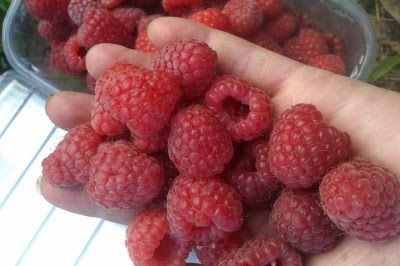
- Authors: Ukraine
- Berry color: purple
- Taste: sweet
- Ripening period: average
- Berry weight, g: 8
- Yield: 4 t / ha
- Frost resistance: high
- Appointment: for fresh consumption, for culinary purposes
- Fruiting period: from the beginning of June and lasts about a month
- Yield rate: high
The raspberry variety Maria was bred by Ukrainian breeders in 1987. It is a very special variety that has both advantages and disadvantages when grown. Gardeners in different areas should consider several factors.
Description of the variety
The raspberry bush Maria is strong, straight, it reaches a height of 170-180 cm. It has upright brown shoots. The leaves are large in size, the leaf plate is dense, has a light edge, wrinkled. There are small thorns on the shoots.
Ripening terms
Maria belongs to varieties with an average ripening period. Berries can be harvested 3-4 times from the beginning of June for about a month.
Yield
The harvest result is about 4 t / ha. Gardeners note that even if watering is somewhat neglected during cultivation, the quality of the crop will not change.
Berries and their taste
The fruits are purple in color, the berries are large, regular in shape, their weight is about 8 g. The flesh tastes sweet, characterized by a pronounced aroma. The fruits can be used both fresh and for making jams, pies, juice and other culinary products.
The advantage of the variety is the preservation of the flavor of the berries during the entire harvest. In addition, the fruits retain their presentation for a long time and have good transportability.

Growing features
When deciding to plant the Maria variety on the site, consider a number of factors.
This raspberry is not picky about the composition of the soil, so do not waste your energy at this stage.
One of Maria's advantages is a small amount of overgrowth, that is, the bush will not creep over the site. This point should be taken into account when choosing a place for planting and when breeding.
The variety is characterized by high resistance to pests and fungal diseases.
It is undesirable to grow such raspberries in the southern regions. Despite being viable in all conditions, this variety does not tolerate heat. At temperatures above +25 degrees, the leaves begin to curl, the bush withers. The fruits also begin to dry out under the influence of the sun. Therefore, the variety is recommended for cultivation in the middle lane.
Site selection and soil preparation
Planting begins in early spring. At the same time, even in the fall, it is important to dig up the site and add organic matter and wood ash. Also, do not forget about removing weeds from the ridge. As mentioned, the plant does not tolerate heat, so choose a location in the shade.
Usually, it is recommended to plant raspberries of this variety with ribbons at a distance of 70-90 cm from each other, the rows are placed at a distance of 150-200 cm.If the variety is planted in an industrial economy, then the row spacing should be at least 250 cm.After planting, the plants are well watered and mulch applied ...


Pruning
In the spring, branches damaged during the winter should be removed. They are pruned to the first living bud. Throughout the summer, you need to clean the bush from root growth, but usually this process does not take much time - the variety is not prone to overgrowth. In the fall, it is allowed to leave 7-8 replacement shoots, and it is better to eliminate the remaining stems - the yield of a heavily thickened bush can be reduced.

Watering and feeding
This variety has a high drought resistance (not to be confused with heat resistance!), Nevertheless it responds well to moisture. This crop needs watering about once a week, and then - if the land has time to dry out. Mulching is recommended to retain moisture in the soil.
If the bush is planted in loam, then it can not be fed for the first 5 years. If the soil is not too fertile, then you can use the following types of fertilizer:
in early spring, nitrogen nutrition will be useful, also do not neglect phosphorus, potassium, calcium;
bird droppings or diluted mullein are relevant once in the summer.


Frost resistance and preparation for winter
Raspberry Maria has high frost resistance, it can withstand temperatures of -30.35 degrees. To make the bush easier to survive this period, you need to untie the branches from the wire, bend to the ground and cover with agrofibre. The more snow there is, the better the plant will endure the winter.


Unfortunately, raspberries, like other plants, do not bypass various diseases and pests. Only armed with the knowledge and the necessary means for this, you can cope with such troubles. To help the plant, it is very important to be able to recognize the disease in time and begin timely treatment.
Reproduction
The variety produces a maximum of 5 replacement shoots per year, therefore it is characterized by a slow propagation process. To increase the root growth, it is allowed to cut the roots within a radius of 50 cm, this manipulation activates the development of new shoots.
Breeding by dividing the bush is also possible. To do this, in an adult strong specimen, the central part is removed and divided into separate seedlings, which are planted in new areas. On the old roots left in the same place, new shoots will also begin to develop.
To obtain seedlings, you can try to propagate the culture by cuttings. To do this, select cuttings with 2-3 buds, sprinkle them horizontally, cover with a layer of straw.Remove the mulch in the spring. Usually, just over half of the cuttings are rooted.








































































